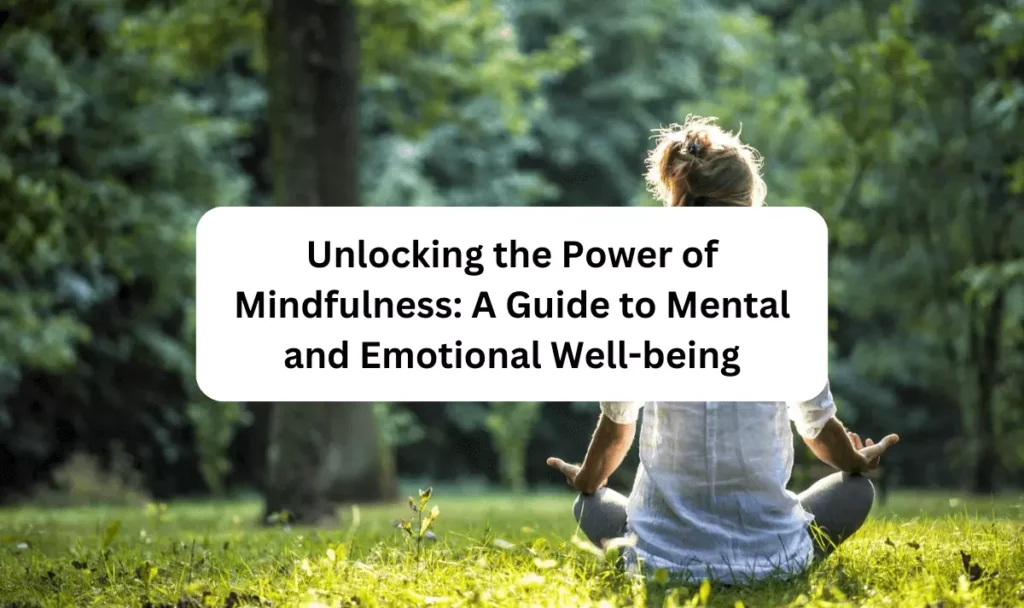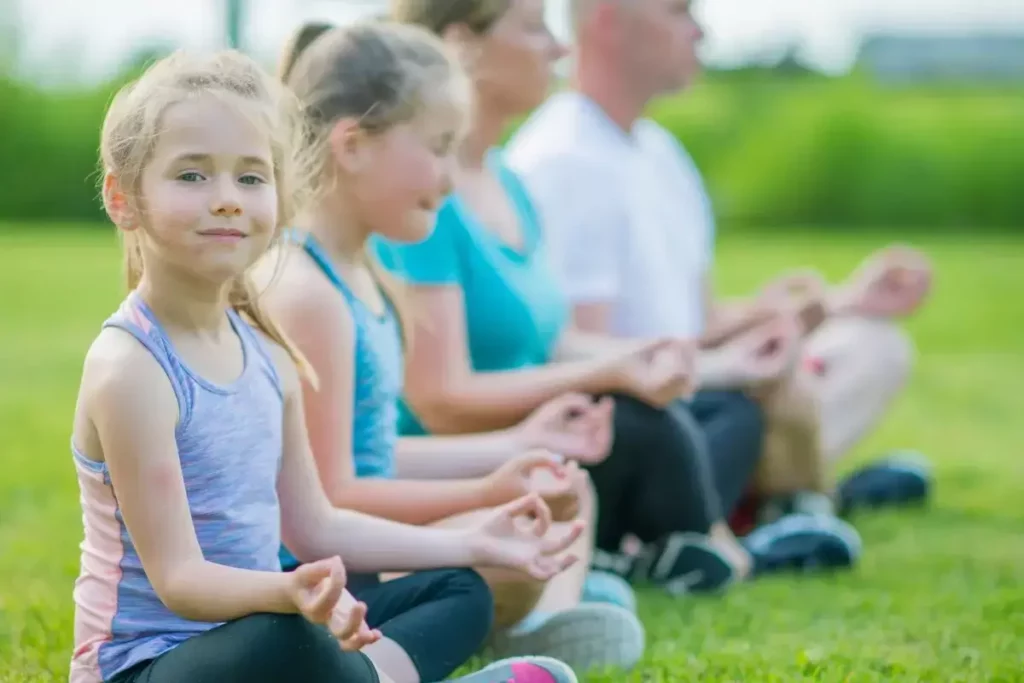
Welcome to this comprehensive guide on unlocking the power of mindfulness for mental and emotional well-being. In today’s fast-paced and often stressful world, cultivating mindfulness can be a transformative practice. This article will delve into the depths of mindfulness, exploring its benefits and providing practical tips on how to incorporate it into your daily life. So, let’s embark on this journey of self-discovery and learn how mindfulness can positively impact your mental and emotional well-being.
May you also like this: The Rise of Plant-Based Diets: Exploring the Benefits of Going Vegan
Content
What is Mindfulness?
Mindfulness is the practice of being fully present and aware in the current moment, without judgment. It involves paying attention to your thoughts, feelings, bodily sensations, and the surrounding environment. By focusing on the present moment, mindfulness helps to cultivate a state of calmness, clarity, and non-reactivity.
The Benefits of Mindfulness
Mindfulness offers a wide range of benefits for mental and emotional well-being. Some of the key benefits include:
- Reduced Stress: Mindfulness helps to lower stress levels by promoting relaxation and reducing the impact of negative thoughts and emotions.
- Improved Emotional Regulation: By being more aware of your emotions, you can better understand and manage them, leading to enhanced emotional well-being.
- Enhanced Focus and Concentration: Practicing mindfulness improves attention and concentration, allowing you to stay more engaged and focused on the task at hand.
- Increased Self-Awareness: Mindfulness cultivates self-awareness, helping you recognize and understand your thoughts, emotions, and patterns of behavior.
- Better Mental Health: Mindfulness has been shown to be effective in reducing symptoms of anxiety, depression, and other mental health conditions.
- Improved Resilience: By developing a mindful approach to life, you can enhance your resilience and cope better with challenges and setbacks.
How to Practice Mindfulness
Practicing mindfulness doesn’t require any special equipment or extensive training. It can be incorporated into your daily routine with simple yet powerful techniques. Here are some steps to get started:
- Find a quiet and comfortable space where you can sit or lie down without distractions.
- Close your eyes and take a few deep breaths to center yourself.
- Focus your attention on your breath, noticing the sensation of each inhalation and exhalation.
- Whenever your mind starts to wander, gently bring your focus back to your breath without judgment.
- Expand your awareness to include your body, noticing any sensations, tension, or areas of discomfort.
- Gradually, broaden your awareness to include sounds, smells, and the environment around you.
- Practice this for a few minutes each day, gradually increasing the duration as you become more comfortable.
Mindfulness Techniques for Stress Reduction

Stress is an inevitable part of life, but mindfulness can help reduce its impact on your well-being. Here are some mindfulness techniques to alleviate stress:
- Body Scan: Close your eyes and systematically scan your body from head to toe, noticing any areas of tension or discomfort. Breathe into these areas and release the tension with each exhale.
- Mindful Breathing: Take a few moments to focus solely on your breath. Notice the sensation of each inhalation and exhalation, allowing your breath to anchor you to the present moment.
- Walking Meditation: Take a walk in nature and pay attention to the sensations in your body as you move. Feel the ground beneath your feet, the air on your skin, and the sounds around you.
- Guided Visualization: Use guided meditation recordings or apps to visualize a peaceful and serene place. Immerse yourself in the details and sensations of this imagined environment.
- Mindful Eating: Slow down and savor each bite of your meal. Pay attention to the flavors, textures, and smells, fully engaging your senses in the act of eating.
Enhancing Emotional Well-being through Mindfulness
Emotions play a significant role in our lives, and mindfulness can help us navigate them more skillfully. Here are some ways to enhance emotional well-being through mindfulness:
- Emotion Awareness: Pause and take a few moments to identify the emotions you are experiencing. Acknowledge them without judgment, allowing yourself to fully feel and accept them.
- RAIN Technique: Recognize, Accept, Investigate, and Non-Identification (RAIN) is a mindfulness practice for dealing with challenging emotions. Recognize the emotion, accept it without resistance, investigate its underlying causes, and let go of identification with it.
- Loving-Kindness Meditation: Practice sending love and kindness to yourself and others. Repeat phrases like “May I be happy, may I be safe, may I be healthy,” extending these wishes to loved ones, acquaintances, and even difficult people in your life.
- Gratitude Practice: Take a few moments each day to reflect on the things you are grateful for. Cultivating gratitude shifts your focus to the positive aspects of life, enhancing emotional well-being.
Cultivating Mindfulness in Relationships
Mindfulness can also have a positive impact on your relationships. Here’s how you can bring mindfulness into your interactions with others:
- Active Listening: When engaging in conversations, give your full attention to the other person. Listen actively without interrupting or formulating responses in your mind.
- Non-Judgmental Observation: Notice your judgments and assumptions about others. Practice suspending judgment and observe them with curiosity and openness.
- Compassionate Communication: Use “I” statements to express your feelings and needs in a non-confrontational manner. Cultivate empathy and understanding when listening to others.
- Mindful Conflict Resolution: During conflicts, take a pause and step back to regain your composure. Approach the situation with an open mind, seeking a mutually beneficial resolution.
Mindfulness and Self-Compassion
Self-compassion is an essential aspect of mindfulness. By treating yourself with kindness and understanding, you can nurture your well-being. Here are some ways to cultivate self-compassion through mindfulness:
- Self-Reflection: Take time for self-reflection and introspection. Notice the inner critic and replace self-judgment with self-compassionate thoughts.
- Self-Care: Prioritize self-care activities that nourish your body, mind, and soul. Engage in activities you enjoy, practice self-compassionate self-talk, and set healthy boundaries.
- Mindful Self-Compassion Meditation: Find guided meditations that specifically focus on cultivating self-compassion. These meditations can help you develop a kind and caring attitude towards yourself.
The Role of Mindfulness in Anxiety Management

Anxiety can be debilitating, but mindfulness can provide effective tools for managing anxious thoughts and feelings. Here’s how mindfulness can help with anxiety:
- Grounding Techniques: When anxiety arises, focus on grounding yourself in the present moment. Use your senses to notice the details of your environment, such as the feel of an object in your hand or the sound of birds chirping outside.
- Thought Labeling: When anxious thoughts arise, mentally label them as “thoughts” rather than facts. Recognize that thoughts are transient and do not define your reality.
- Breathing Exercises: Engage in deep, diaphragmatic breathing to activate the body’s relaxation response. Focus on the sensation of your breath, allowing it to anchor you in the present moment.
- Acceptance of Uncertainty: Anxiety often stems from a fear of the unknown. Practice accepting uncertainty as a natural part of life and focus on what you can control in the present moment.
Mindfulness for Better Sleep
Getting quality sleep is essential for overall well-being, and mindfulness can help improve sleep patterns. Here are some mindfulness practices to promote better sleep:
- Bedtime Ritual: Establish a relaxing bedtime routine to signal to your body that it’s time to sleep. Engage in calming activities such as reading, taking a warm bath, or practicing gentle stretches.
- Mindful Breathing before Sleep: Lie down in bed and bring your attention to your breath. Slowly inhale and exhale, focusing on the sensations of each breath. Allow any thoughts or worries to pass by without engaging with them.
- Body Relaxation: Progressive muscle relaxation is a technique that involves tensing and releasing different muscle groups. Start from your toes and work your way up to your head, releasing tension as you go.
- Letting Go of the Day: Before sleep, take a few moments to mentally let go of the events of the day. Acknowledge any unfinished tasks or worries, and set the intention to address them the next day.
Mindfulness and Cognitive Function
Mindfulness practice can enhance cognitive function and mental clarity. Here’s how mindfulness can benefit your cognitive abilities:
- Attention and Focus: Regular mindfulness practice improves attention and focus by training the mind to stay present and resist distractions.
- Memory Enhancement: Mindfulness can enhance working memory and improve recall by increasing the ability to encode and store information.
- Cognitive Flexibility: By fostering non-reactivity and open-mindedness, mindfulness enhances cognitive flexibility—the ability to adapt to new situations and perspectives.
- Decision Making: Mindfulness helps cultivate a state of calmness and clarity, enabling better decision-making by reducing impulsive reactions and increasing thoughtful responses.
Mindfulness in the Workplace
Bringing mindfulness into the workplace can foster a more positive and productive work environment. Here’s how mindfulness can be applied at work:
- Mindful Breaks: Take short mindfulness breaks during the workday to reset and recharge. Engage in a brief meditation, practice deep breathing, or simply focus on the present moment.
- Non-Judgmental Observation: Practice observing your thoughts and emotions without judgment in the workplace. This can help you respond to challenges and interactions with more clarity and objectivity.
- Mindful Communication: Pay attention to your communication style, ensuring that your words and actions are mindful and respectful. Listen actively and practice empathy in your interactions with colleagues.
- Mindful Work Practices: Engage in one task at a time, fully immersing yourself in the present moment. Avoid multitasking, as it can lead to decreased focus and productivity.
Mindfulness for Children and Adolescents

Teaching mindfulness to children and adolescents can equip them with valuable tools for managing stress, emotions, and social interactions. Here are some ways to introduce mindfulness to young individuals:
- Mindful Breathing: Teach children to focus on their breath by taking slow, deep breaths. Encourage them to notice how their breath feels in their bodies.
- Mindful Listening: Engage children in listening exercises where they pay attention to sounds in their environment without judgment.
- Mindful Coloring: Coloring books designed for mindfulness can help children focus on the present moment and express their creativity.
- Mindful Movement: Introduce yoga or simple stretching exercises that encourage children to be aware of their bodies and movements.
- Mindful Storytelling: Use stories or books with mindfulness themes to teach children about the practice and its benefits.
Mindfulness Apps and Resources
There are numerous mindfulness apps and resources available to support your mindfulness journey. Some popular ones include:
- Headspace: Offers guided meditations, sleep sounds, and mindfulness exercises.
- Calm: Provides guided meditations, breathing exercises, and sleep stories.
- Insight Timer: Offers a vast collection of guided meditations and mindfulness courses.
- The Mindfulness App: Features guided meditations, reminders, and a timer for self-guided practice.
- UCLA Mindful Awareness Research Center: Provides free guided meditations and resources for mindfulness practice.
Further reading suggestion for you: The Art of Restful Sleep – Tips for a Good Night’s Rest
Common Misconceptions about Mindfulness
There are some common misconceptions about mindfulness that may hinder its adoption. Let’s address a few of them:
- Mindfulness is about emptying the mind: Mindfulness is not about clearing the mind of thoughts. It’s about observing thoughts without judgment and bringing attention back to the present moment.
- Mindfulness is religious: While mindfulness has roots in Buddhist traditions, it can be practiced by people of any religious or spiritual background.
- Mindfulness is time-consuming: Even a few minutes of mindfulness practice can have significant benefits. It’s about quality, not quantity.
- Mindfulness is a quick fix: Mindfulness is a skill that develops over time with consistent practice. It requires patience and commitment to experience its full benefits.
Conclusion
Mindfulness is a powerful practice that can transform your mental and emotional well-being. By cultivating present-moment awareness, non-judgment, and self-compassion, you can unlock the potential of mindfulness in various aspects of your life. Whether you’re seeking stress reduction, improved relationships, enhanced cognitive function, or better sleep, mindfulness can be a valuable tool. Start incorporating mindfulness into your daily routine and embark on a journey of self-discovery and well-being.
Can mindfulness help with chronic pain?
Yes, mindfulness has been shown to reduce the impact of chronic pain by changing the way it is perceived and managed.
How long does it take to see the benefits of mindfulness practice?
The benefits of mindfulness can be experienced in the short term, such as increased relaxation and reduced stress. Long-term practice can lead to more profound changes in emotional well-being and cognitive function.
Can mindfulness be practiced during daily activities?
Absolutely! Mindfulness can be integrated into daily activities such as eating, walking, or even washing dishes. It’s about bringing your full attention and awareness to the present moment.
Is mindfulness suitable for everyone?
Mindfulness can be beneficial for most individuals. However, if you have a history of trauma or severe mental health conditions, it’s important to work with a qualified professional to ensure it is practiced safely.
Can mindfulness replace therapy or medication for mental health conditions?
Mindfulness can be a helpful complement to therapy or medication for mental health conditions. It’s important to consult with healthcare professionals to develop a comprehensive treatment plan.

Kylie Davidson is a health blogger and the founder of her own blog about fitness. She has been blogging for three years now and loves to share what she learns with others. Kylie enjoys reading, cooking, and staying active outdoors.












